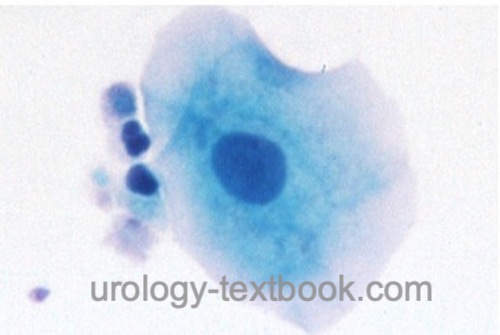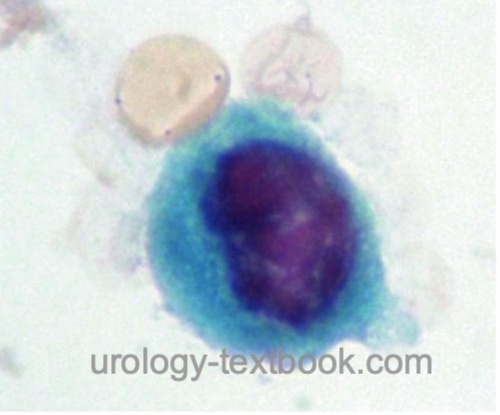You are here: Urology Textbook > Urologic examinations > Urine cytology
Urine Cytology
Indications:
- Diagnosis of bladder cancer, urethral cancer or upper urinary tract cancer (in unclear cases).
- Follow-up of bladder cancer with an intermediate or high risk for recurrence or progression.
- Follow-up of upper urinary tract cancer.
Preparing the Specimen for Urine Cytology
Use fresh urine for cytology, morning urine is not suitable due to osmotic artifacts. An irrigation of the bladder or upper urinary tract with 5–20 ml NaCl is an alternative to voided urine. The urine or the irrigation fluid is centrifuged, the cells are fixed on a slide and stained (e.g., Papanicolaou's technique or quick staining techniques).
 |
 |
Reporting:
Normal urothelial cells are large and contain a small round nucleus with fine homogenous chromatine [fig. normal urothelial cell]. Depending on the dedifferentiation of the urothelial cells, the nuclear-cytoplasmic ratio increases as the nucleus enlarges and the cells become smaller [fig. high-grade cancer cell]. In addition, the nucleus becomes irregular in regarding to form and chromatine, see table criteria for malignancy of urothelial cells. Urine cytology is observer-dependent. However, in experienced hands specificity exceeds 90% for the detection of high-grade tumor cells. Well-differentiated tumors are more difficult to identify, since fewer cells are shed and the differences between inflammation and well-differentiated tumors are not unequivocal.
| • Increased nuclear-cytoplasmic ratio |
| • Irregular shaped nuclei |
| • Multiple and unregular nucleoli |
| • Thick and unregular nuclear membrane |
| • Hyperchromasia: increased staining of the nucleus |
| • Coarsely clumped chromatine |
The microscopic examination of exfoliated urothelial cells in voided urine can reliably identify G2 and G3 cells of urothelial carcinoma. Well-differentiated tumors are more difficult to identify, since fewer cells are shed and the differences between inflammation and well-differentiated tumors are not unequivocal.
| 24-h urine | Index | Semen analysis |
Index: 1–9 A B C D E F G H I J K L M N O P Q R S T U V W X Y Z
References
Rathert, P. & Roth, S. Urinzytologie: Praxis und AtlasSpringer Verlag, Berlin, 2008
 Deutsche Version: Urinzytologie
Deutsche Version: Urinzytologie
Urology-Textbook.com – Choose the Ad-Free, Professional Resource
This website is designed for physicians and medical professionals. It presents diseases of the genital organs through detailed text and images. Some content may not be suitable for children or sensitive readers. Many illustrations are available exclusively to Steady members. Are you a physician and interested in supporting this project? Join Steady to unlock full access to all images and enjoy an ad-free experience. Try it free for 7 days—no obligation.